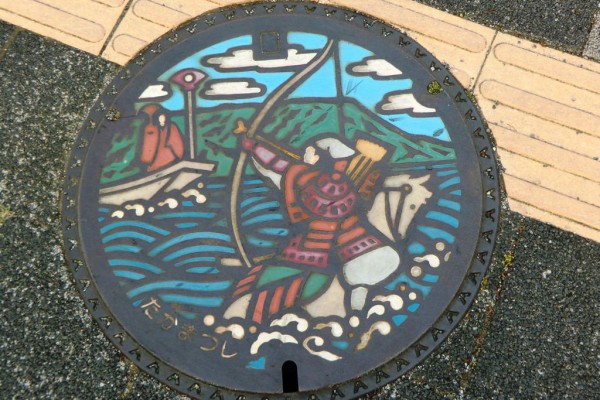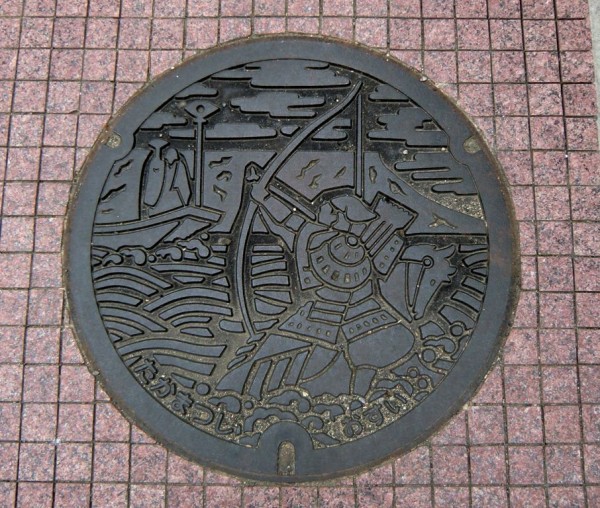As you may already know if you’ve been to Japan (or if you read blogs about Japan, the topic being very common) pretty much every city in the country has personalized manhole covers, usually representing a famous element of that city.
Let’s take a look at manhole covers in Takamatsu:
They represent a famous episode of the very famous Battle of Yashima that took place in 1185 on Yashima and in the vicinity (i.e. in Takamatsu).
And this is a perfect occasion to tell you a little bit about this battle.
The Battle of Yashima
Between 1180 and 1185, the Genpei War opposed the Taira clan to the Minamoto clan. There was a lot at stake, namely the future of Japan, as whichever clan would win the war, would seize control of the entire country. It originated from various conflicts and tensions concerning the imperial succession, as Emperor Antoku was only one year old when he was crowned, and a certain number of people thought that it was a good occasion to grab power out of his tiny hands.
One can summarize the Battle of Yashima as follow:
In 1185, the war had already been pretty fierce for about five years. The Taira clan (the loyalist faction of Emperor Antoku, who was six years old at the time) had just fleed Kobe where the capital was at the time as the clan had been chased from Kyōto. They had found refuge on Yashima, which was an actual island at the time (well it still technically is as it’s surrounded by a saltwater canal) although it was accessible by foot at low tide. A more or less temporary palace had even been built. From its configuration (a high plateau surrounded by steep slopes and cliffs in the south and the sea in the north), Yashima was pretty difficult to attack and relatively easy to defend.
The Minamoto clan who was chasing them had managed to reach Shikoku, but a severe storm had almost destroyed their fleet and only about a hundred samurais were getting ready to attack the Taira clan that, even weakened, could defend itself quite easily against such a small army.
However, unaware that the Minamoto were already on Shikoku and that their fleet had been partly destroyed, the Taira were expecting an attack coming from the sea.
So, on the night of March 21st, 1185, when the Taira saw dozens if not hundreds of bonfires being lit just south of Yashima, they were greatly surprised. They believed that a large army had arrived from the south and that it would not only prevent them from retreating inland if necessary but also block their supply routes.
The Minamoto managed to accomplish such a deception thanks to sympathizers among the local population who had helped them light those bonfires and pretend to be that large army. Thinking they were about to be besieged and stuck between that army in the south and the Minamoto fleet in the north (remember, they still thought the fleet was about to arrive at any time), the Taira clan decided to leave Yashima as soon as possible. And the retreat had to be rushed when the Minamoto samurais started their assault at dawn from the south east side.
The Taira clan managed to escape to Dan no Ura (today’s Shimonoseki in Yamaguchi Prefecture) where it was defeated once and for all one month later.
So what is the drawing on the manhole cover about?
It represents Nasu no Yoichi, a Minamoto samurai who chased a Taira ship well into the sea with his horse. The people on the boat taunted him with a fan attached to a pole (that fan being both a rallying sign and an invincibility symbol). He then took his bow and with a single shot, on his horse basically swimming in the sea, he hit the fan that fell into the water before the ship could flee in the distance. This symbolic act ridiculed the Taira even more – as if their defeat was not enough – and cemented Nasu no Yoichi’s reputation as one of the best marksmen in Japan.

But if the “big” story stops here (the one that is famous all over Japan), the small and local lore has one more episode.
A few days later, the people from one of the small islands near Yashima found the fan that had washed ashore on their beach. And as time passed and the story of Nasu no Yoichi became more and more famous, people started calling this island the “fan’s island” or in Japanese: Ohgijima…
(and while the kanji used to name this island have changed with time, the pronunciation barely has)


Cool! An in-depth background story of the archer on the manhole.
I love the coloured ones.
Yeah, I like the colored ones much better too, as the monochrome one can be a bot confusing if you don’t know what you’re looking at.
I grinned when I read Lina’s comment. She’s the world’s biggest manhole covers fan!
This was a nice read. I love these old stories, and how they still crop up in unexpected places.
Great to hear the story behind the manhole cover, and agree that the coloured one certainly stand out a lot more. I love how these manhole covers tell a story or represent something about the area from which they are from.